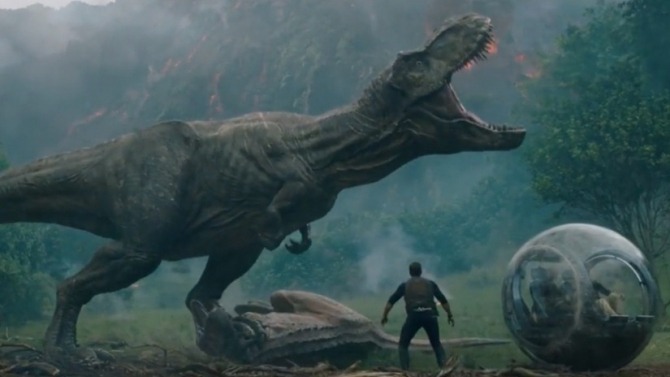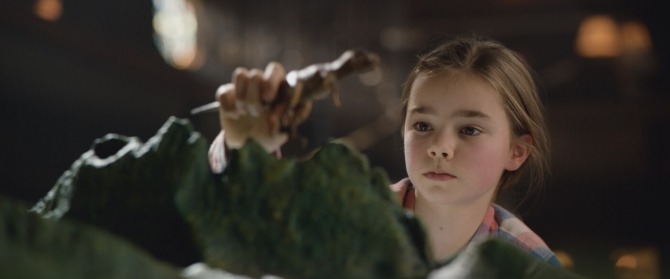Warning – this article contains massive spoilers for Jurassic World: Fallen Kingdom.
The fifth instalment in the Jurassic Park franchise is a tonally mixed romp that takes the series in some slightly different directions (check out our review). With a third part of the Jurassic World trilogy (ie. a 6th Jurassic Park film) already slated for 2021 with Jurassic World director Colin Trevorrow returning to take the helm, there’s plenty to unpick about the ending of Fallen Kingdom and what it might mean for the franchise.

“Welcome to Jurassic World”
By the end of the movie then, Isla Nublar has been destroyed by a volcano, but several species of dino have been transported from the island in what originally looked like a rescue mission but turned out to be a black-market smuggling operation.
Back on the mainland and the sedated dinos are transport to the Lockwood Estate – the home of one of Doctor John Hammond’s (Richard Attenborough) now old and sick associates Benjamin Lockwood (James Cromwell), who also believes he’s part of a rescue mission to protect these endangered species. Sadly he’s incapacitated and doesn’t realise that his dastardly assistant Eli Mills (Rafe Spall) is in cahoots with ruthless businessman Gunnar Eversol (Toby Jones) who intends to auction the creatures to a range of foreign cartoon villains for the highest price.
Unsurprisingly it ends badly. By the close of the movie many of the baddies have been eaten and the surviving dinosaurs have now been released into mainland America.
The movie is bookended by a court case involving Doctor Ian Malcolm (Jeff Goldblum), who is initially petitioning for the dinos to be left to die on Isla Nublar and rounds out the movie with the line “welcome to Jurassic World”, a bit like this bit in Family Guy…
We’re now left with a world where humans and dinos have to either find a way to co-exist, or will end up battling against one another.
The ending felt a bit like the new Planet Of The Apes franchise, with the juxtaposition of dinosaurs against built up urban areas and man-made structures (a bit like the scene of a chimp riding a horse over the Golden Gate Bridge in Rise Of The Planet Of The Apes).
Rise of the planet of the dinos?
While in the new Planet Of The Apes movies we saw genetically modified simians grow intelligence and learn to organise and then militarise themselves, that’s going to be tougher for the dinos.
When we see Claire (Bryce Dallas Howard) releasing the captive creatures at Lockwood Estate it’s around 18 enclosures she opens. It’s also implied when the Isla Nublar rescue/kidnap mission is going on that they are attempting to bag as many different species as possible, so although at the end it certainly looks like there’s more than one of those tiny dinos – the Compsognathus (I think) and most of the others seem to be the sole surviving members of their species. Not to mention the fact that these dinosaurs are all female, meaning any kind of reproduction seems unlikely. Although there’s always the frog DNA factor – in the original Jurassic Park frog DNA was used to fill the gaps in the dino DNA sequences, which allowed female dinos to change sex and breed, meaning it’s entirely possible to write around this if they do decide to Planet Of The Apes it.
We do see that vials of DNA from all the different species do make it out in the hands of Mills’ goons, which doesn’t bode well, meaning there’s a definite possibility of further cloning. Fallen Kingdom already touched on the idea of weaponising dinosaurs and while this was only explored as a concept via the prototype Indoraptor, who’s dead by the end of the movie, there’s certainly scope to take this further. And though the Indoraptor is dead, that’s not to say someone couldn’t harvest her DNA and recreate this hybrid again. Except…
No more hybrids
Well, except that Colin Trevorrow has said he’s somewhat done with dino hybrids. Talking to Total Film magazine, he said:
“I’m looking forward to, in the third film, getting a little back into the Paleontological, wild animal, true dinosaur nature of all of it,” and said that he’d been very careful and tentative about the whole hybrid plotline stuff. That doesn’t actually mean there won’t be another Indoraptor of course, but we’re unlikely to encounter a Triceri-raptor Rex or similar. Cool though that would be.
Blue is the warmest raptor
The Indoraptor was of course ultimately defeated by super-intelligent and highly socialised raptor Blue. Blue’s human best pal Owen (Chris Pratt) appeals to Blue and says he’ll take her to safety but she declines, prefering to run free than risk being caged again (in a scene which is also pretty reminiscent of the end of Rise Of The Planet Of The Apes).
There’s no way the third part of the Jurassic World trilogy can ignore Blue’s arc so we’re sure she’ll be back in some form. And don’t forget, she’s had a blood transfusion from a T-Rex, so her DNA is “pretty much a sock drawer” according to paleontological vet Zia (Daniella Pineda). What effect will that have, if any, remains to be seen.
Doctor Ian Malcolm
Also still in the game is Jeff Goldblum’s Doctor Malcolm. Ok he’s hardly in Fallen Kingdom, but he takes the role of the prescient voice of reason here, advising they try to reverse the mistakes they made by messing with nature, and then eventually predicting that humanity would now be entering into an entirely new era which would be shared with dinosaurs.
Depending on Goldblum’s schedule he could easily be a really central character in 3, helping to unpick the mess we find ourselves in at the end of Fallen Kingdom.
Maisie’s eye
Lockwood’s daughter/granddaughter Maisie (Isabella Sermon) provided one of the movie’s biggest twists. Turns out she’s a clone – Lockwood’s child was killed in a car crash but he had the means and so opted to use her DNA to create a new version which he raised as a granddaughter. This is apparently why he and Hammond fell out (because it’s totally fine to create an entire island populated with dinosaurs which inevitably causes havoc and massive loss of life, but bringing back your own kid is a travesty. Whatever Hammond).

The very end of Fallen Kingdom includes a lingering shot close up of Maisie’s eye. The camera holds on this frame for so long that I totally expected a second dino-style eyelid to flash across her eye. It didn’t happen but the implication that her DNA might not be entirely human was certainly teased.
This is less of a leap than it sounds. A very early draft of what turned into Jurassic World featured human-dino hybrids, although these were less ‘adorable little girl with intriguing eyes’ and more ‘ferocious Minotaur’. Or Manosaur if you like.
The meddling with DNA and merging of the species could be a direction Trevorrow takes. Talking to EW he said:
“If I could contextualize each film, I would say Jurassic World was an action adventure, Fallen Kingdom is kind of a horror suspense film, and Jurassic World 3 will be a science thriller in the same way that Jurassic Park was.”
Post-credits sequence
Yes, there’s a post-credits sting, right at the very end! But it doesn’t actually set up a great deal. Instead it’s kind of a gag which speaks to a particular horror trope. After the credits we see pterodactyls flying round a tower, which is revealed to be the Eiffel Tower! Have the dinos spread to France already? Well in fact no, it turns out it’s the Eiffel Tower in Las Vegas. It’s a nice touch which still teases the idea that with flying dinosaurs it wouldn’t take much of a stretch for them to begin to reach other countries and co-inhabit the world.

